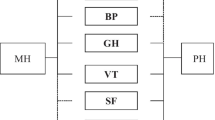Abstract
Objective: To test the construct validity of the Short-Form 36 (SF-36) Health Survey, using structural equation modeling (SEM). Methods: Cross -sectional survey was conducted. Data were collected from 1007 participants in a stratified sample of adult general population, interviewed face-to-face by trained interviewers. Results: SEM analyses supported the superiority of the eight first-order factor model of health. Higher -order analyses suggested that a model with three correlated second-order factors (physical health, general well-being, general mental health) and one third-order factor (health) provided a satisfactory fit to the data. Conclusions: These results confirm the multidimensional structure of the SF-36 and underscore the feasibility of multinational comparisons of health status using this instrument. They also support the use of eight subscale scores in parallel with three second -order summary scores rather than one overall score.
Similar content being viewed by others

References
JE Ware B. Gandek (1998) ArticleTitleQverview of the SF-36 Health Survey and the international quality of life assessment (IQOLA) Project J Clin Epidemiol 51 IssueID11 903–912 Occurrence Handle10.1016/S0895-4356(98)00081-X Occurrence Handle9817107
JE Ware M Kosinski B. Gandek (2003) SF-36 Health Survey: Manual and Interpretation Guide QualityMetric Inc Lincoln RI
JE Ware M Kosinski B Gandek et al. (1998) ArticleTitleThe factor structure of the SF-36 Health Survey in 10 countries: Results from the IQOLA Project J Clin Epidemiol 51 IssueID11 1159–1165 Occurrence Handle10.1016/S0895-4356(98)00107-3 Occurrence Handle9817133
RB. Kline (1998) Principles and Practice of Structural Equation Modeling The Guilford Press New York
SD Keller JE Ware PM Bentler et al. (1998) ArticleTitleUse of structural equation modeling to test the construct validity of the SF −36 Health Survey in ten countries: Results from the IQOLA Project J Clin Epidemiol 51 IssueID11 1179–1188 Occurrence Handle10.1016/S0895-4356(98)00110-3 Occurrence Handle9817136
E Pappa N Kontodimopoulos D. Niakas (2005) ArticleTitleValidating and norming of the Greek SF-36 Health Survey Qual Life Res 14 1433–1438 Occurrence Handle10.1007/s11136-004-6014-y Occurrence Handle16047519
SD Keller JE Ware B Gandek et al. (1998) ArticleTitleTesting the equivalence of translations of widely used response choice labels: Results from the IQOLA Project J Clin Epidemiol 51 IssueID11 933–944 Occurrence Handle10.1016/S0895-4356(98)00084-5 Occurrence Handle9817110
M Bullinger J Alonso G Apolone et al. (1998) ArticleTitleTranslating health status questionnaires and evaluating their quality: The IQOLA Project approach J Clin Epidemiol 51 IssueID11 913–923 Occurrence Handle10.1016/S0895-4356(98)00082-1 Occurrence Handle9817108
AK Wagner B Gandek NK Aaronson et al. (1998) ArticleTitleCross-cultural comparisons of the content of SF-36 translations across 10 countries: Results from the IQOLA Project J Clin Epidemiol 51 IssueID11 925–932 Occurrence Handle10.1016/S0895-4356(98)00083-3 Occurrence Handle9817109
B Gandek JE. Ware (1998) ArticleTitleMethods for validating and norming translations of health status questionnaires: The IQOLA Project approach J Clin Epidemiol 51 IssueID11 953–959 Occurrence Handle10.1016/S0895-4356(98)00086-9 Occurrence Handle9817112
K Joreskog D. Sorbom (1996) LISREL 8: User’s Reference Guide Scientific Software International Chicago IL
L Hu PM. Bentler (1998) ArticleTitleFit indices in covariance structure modeling: Sensitivity to underparameterized model misspecification Psychol Methods 3 IssueID4 424–453 Occurrence Handle10.1037//1082-989X.3.1.3
RP McDonald MR. Ho (2002) ArticleTitlePrinciples and practice in reporting structural equation analyses Psychol Methods 7 IssueID1 64–82 Occurrence Handle10.1037//1082-989X.7.1.64 Occurrence Handle11928891
MW Browne R. Cudeck (1993) Alternative ways of assessing model fit KA Bollen JS Long (Eds) Testing Structural Equation Models. Sage Thousand Oaks CA 136–162
JE Ware M. Kosinski (2001) ArticleTitleInterpreting SF-36 summary health measures: A response Qual Life Res 10 405–413 Occurrence Handle10.1023/A:1012588218728 Occurrence Handle11763203
Author information
Authors and Affiliations
Corresponding author
Rights and permissions
About this article
Cite this article
Anagnostopoulos, F., Niakas, D. & Pappa, E. Construct Validation of the Greek SF-36 Health Survey. Qual Life Res 14, 1959–1965 (2005). https://doi.org/10.1007/s11136-005-3866-8
Accepted:
Issue Date:
DOI: https://doi.org/10.1007/s11136-005-3866-8


